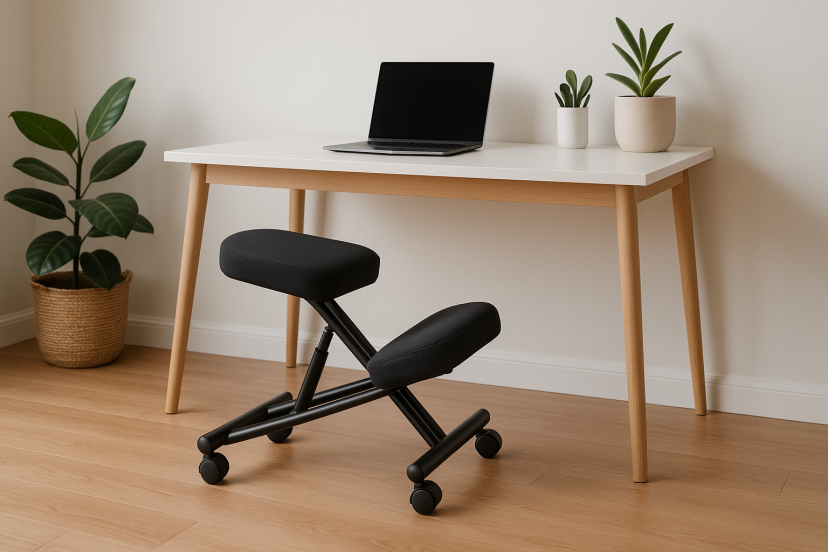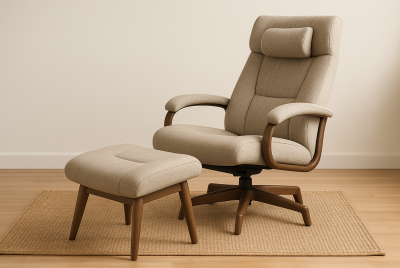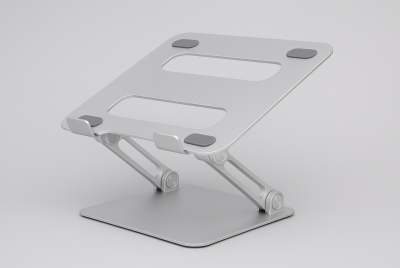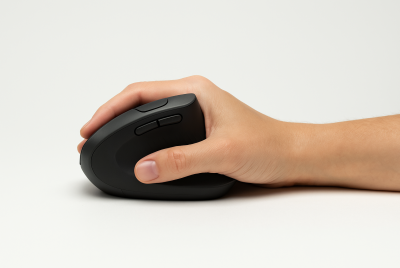Ergonomic Kneeling Stool for Back Pain Relief & Comfort
We may earn a commission for purchases made using our links. Please see our disclosure to learn more.
Do you spend hours at your desk only to feel sore and stiff by the end of the day? The problem is that regular chairs keep your body in an unhealthy position that leads to poor posture and back pain. Over time, this strain can turn into bigger health issues. Fortunately, the solution is quite simple. An ergonomic kneeling stool tilts your hips forward, keeps your spine aligned, and eases pressure on your lower back. It helps you sit upright, stay active, and feel more comfortable. In this guide, you’ll learn how it works, why it’s backed by research, and which stools are the best to try.
What Is an Ergonomic Kneeling Stool?
An ergonomic kneeling stool is not your average chair. Instead of sitting at a 90-degree angle, your thighs rest at about 60–70 degrees while your shins rest on padded supports. This position opens up the hips, straightens the spine, and engages your core. Unlike a standard chair that encourages slouching, a kneeling stool naturally trains your body to maintain a healthier posture. It’s a small adjustment that makes a big difference for your comfort and productivity.
Research supports these benefits. A study on ergonomically designed kneeling chairs found that chairs set at a +20° inclination help preserve the natural lumbar curve almost as well as standing posture. Another study on sitting configuration and hip joint forces showed that kneeling chairs reduce hip flexion angles and joint stress compared to traditional office seating.
Benefits of Using a Kneeling Stool
Better Posture
By rotating the pelvis slightly forward, a kneeling stool helps your spine stack naturally. This upright posture minimizes slouching and helps you look and feel more confident.
Relief from Back and Neck Pain
If you’ve ever stood up after a long day and felt a pinch in your lower back, you’ll appreciate the relief these stools offer. Studies in Applied Ergonomics show that kneeling chairs reduce spinal compression and ease lumbar strain.
Boosted Energy and Focus
Good posture isn’t just about health—it also improves mental performance. Sitting upright increases circulation, oxygen flow, and alertness, helping you stay sharp during long work sessions.
Supported by Science
According to the Journal of Physical Therapy Science, kneeling chairs reduce pressure on the lumbar spine compared to traditional office seating. Experts agree that alternating between postures—standing, sitting, and kneeling—creates the healthiest routine.
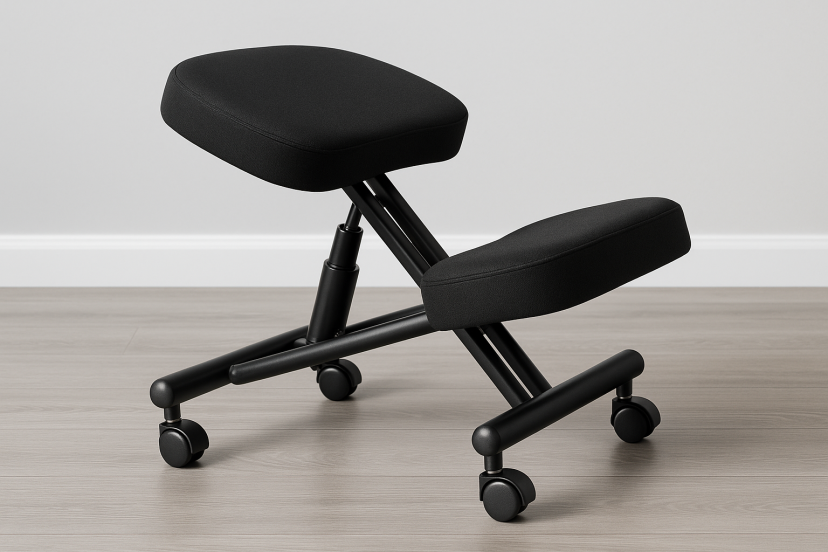
5 Best Ergonomic Kneeling Stools
Below are five excellent options you can buy today. Every model offers distinct features tailored to suit different needs and preferences.
1. DRAGONN Ergonomic Kneeling Chair
This is one of the most popular kneeling stools—and for good reason. With thick 4-inch cushions and adjustable height, it combines comfort with durability.
- Features: Steel frame, adjustable height (21–28”), supports up to 250 lbs.
- Pros: Excellent padding, sturdy build, easy assembly.
- Cons: Slightly bulky for compact desks.
👉 Ideal for: Anyone who wants a reliable, heavy-duty kneeling chair for daily office use.
2. Adjustable Rocking Kneeling Chair
This model adds a rocking motion, encouraging micro-movements that keep muscles active throughout the day.
- Features: Rocking frame, ergonomic angled seat, breathable fabric cushions.
- Pros: Promotes dynamic sitting, stylish design.
- Cons: May take time to adjust if you’re used to stationary seating.
👉 Ideal for: People who fidget or prefer movement while working.
3. Kneeling Chair with Casters
This option blends mobility with ergonomic design. With smooth casters and a braking system, it’s perfect for switching between tasks.
- Features: Angled seat, molded foam cushions, caster wheels with brake.
- Pros: Easy to move around, thick padding.
- Cons: Wheels may roll too easily on slick floors.
👉 Ideal for: Home offices where you need to move frequently.
4. NYPOT Ergonomic Kneeling Chair
Built with adjustability in mind, this stool allows you to fine-tune seat height and cushion positioning for maximum comfort.
- Features: Adjustable design, durable wood frame, comfortable knee pads.
- Pros: Highly customizable, elegant wooden look.
- Cons: Assembly may take longer than expected.
👉 Ideal for: Users who want tailored comfort and a stylish design.
5. Flash Furniture Wooden Kneeling Chair
A compact, budget-friendly option with a simple wooden frame. Its light frame allows for quick moving and easy storage.
- Features: Wooden base, padded seat and knee rests, minimalist design.
- Pros: Affordable, great for small spaces.
- Cons: Limited adjustability compared to other models.
👉 Ideal for: Beginners who want to try kneeling stools without spending too much.
| Product | Key Features | Pros | Cons |
| DRAGONN Ergonomic Kneeling Chair | 4″ thick cushions, adjustable height (21–28″), steel frame, supports up to 250 lbs | Durable build, excellent padding, easy assembly | Bulky for small desks |
| Adjustable Rocking Kneeling Chair | Rocking frame, angled seat, breathable fabric cushions | Promotes active sitting, stylish design | Takes time to adjust if new to kneeling |
| Kneeling Chair with Casters | Angled seat, molded foam cushions, wheels with brake system | Easy mobility, thick padding | Wheels may roll too easily on slick floors |
| NYPOT Ergonomic Kneeling Chair | Adjustable seat and cushions, durable wood frame, padded knee rests | Highly customizable, elegant wooden look | Assembly can take longer |
| Flash Furniture Wooden Kneeling Chair | Compact wooden frame, padded seat and shin supports | Affordable, lightweight, good for small spaces | Limited adjustability |
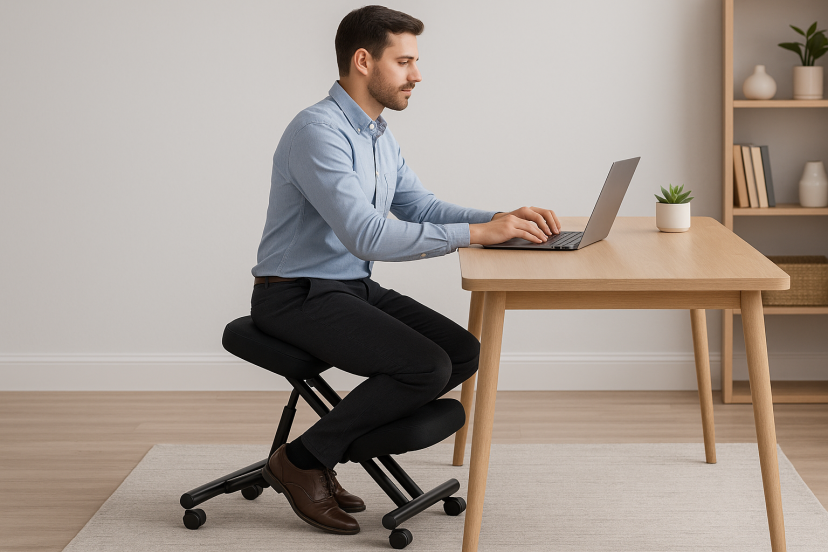
How to Use a Kneeling Stool Properly
- Adjust the height: Your hips should rest slightly above your knees.
- Start slow: Begin with 20–30 minutes daily and increase gradually.
- Alternate postures: Mix kneeling with standing desks or ergonomic chairs.
- Take breaks: Get up to stretch and take a short walk once an hour to keep your blood flowing.
Conclusion
An ergonomic kneeling stool isn’t just a unique office chair—it’s a proven way to improve posture, reduce back pain, and stay focused throughout the day. While it takes a short adjustment period, the long-term benefits make it a smart choice. For even better support, pair your stool with other ergonomic essentials. Carrying a best ergonomic backpack helps maintain good posture beyond the office, creating a healthier routine overall.
FAQs
1. Are ergonomic kneeling stools good for long hours?
They’re best used in intervals. Alternate with an ergonomic chair or standing desk.
2. Do kneeling stools hurt your knees?
Not if you choose one with thick padding. Any discomfort usually fades as your body adjusts.
3. Can a kneeling stool replace a regular office chair?
It shouldn’t fully replace one. Use it as part of a varied sitting routine.
4. What’s the best ergonomic kneeling stool for beginners?
Budget-friendly models like the Flash Furniture stool or mid-range picks like DRAGONN are great starts.
5. Are kneeling stools recommended by doctors?
Many physiotherapists and ergonomists recommend them for posture support, though people with existing conditions should consult a doctor first.

